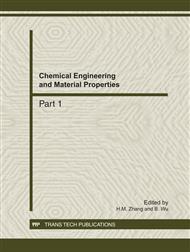p.121
p.126
p.130
p.134
p.138
p.143
p.147
p.151
p.156
Torque Rheological Properties of Bamboo Flour/PP Composites
Abstract:
The rheological behavior of plant flour reinforced thermoplastics composites is very important to practical industry, however few research especially research about bamboo flour reinforced polypropylene(PP) composites is available regarding rheological field. In this paper, the torque rheometer made in Shanghai was used to examine the flow behavior of bamboo flour filled PP composites. The orthogonal test was adopted to analyze how three factors(weight percentage of bamboo, weight percentage of MAPP and rotate speed) influence the behavior of composites. The result indicated that bamboo flour filled PP composites was pseudo-plastics or shear-thinning flow under the experimental condition investigated. The effect of weight percentage of bamboo on rheological peoperties was signigficant,but the effect of both of the rest of two factors on rheological was not significant under the given experimental condition.
Info:
Periodical:
Pages:
138-142
Citation:
Online since:
December 2011
Authors:
Keywords:
Price:
Сopyright:
© 2012 Trans Tech Publications Ltd. All Rights Reserved
Share:
Citation:


